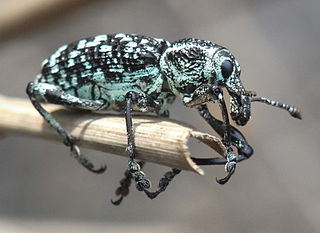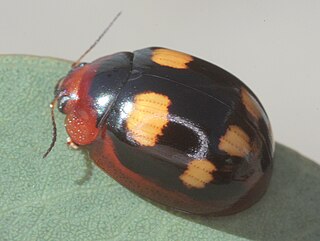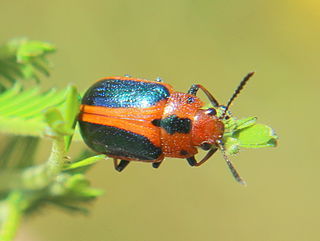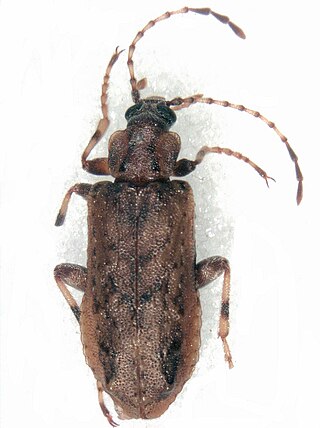
The longhorn beetles (Cerambycidae), also known as long-horned or longicorns, are a large family of beetles, with over 35,000 species described.

Chrysolopus spectabilis is a species of weevil found in south-eastern Australia. It was discovered during James Cook's first voyage, and became one of the first insects to be described from Australia. The weevil measures up to 25 mm (1.0 in) long and includes distinctive metallic green and black scales. It is found only on 28 species of the plant genus Acacia.

The Chrysomelinae are a subfamily of leaf beetles (Chrysomelidae), commonly known as broad-bodied leaf beetles or broad-shouldered leaf beetles. It includes some 3,000 species around the world.

Paropsis is a genus of Chrysomelidae, commonly referred to as tortoise beetles, which includes over 70 described species. Their small size, bright colours and patterns, and roughly hemispherical shape cause them to be mistaken for beetles in the family Coccinellidae (ladybirds). They are distributed across Australia, New Zealand and Papua New Guinea. Some species, Paropsis atomaria in particular, have been introduced to the United States in California with first official documented sightings in 2022. They primarily feed on Eucalyptus but there are a few that feed on Baeckea, Kunzea and Leptospermum. Species within this genus are noted as pests. For example, Paropsis charybdis is a pest of Eucalyptus in New Zealand.

Bolboceratidae is a family of beetle. It was historically treated as a subfamily of the earth-boring dung beetles, or "dor beetles", but has been considered a separate family by many authors since 1995. Some recent classifications have persisted in treating bolboceratids as a subfamily (e.g.) but these classifications are contradicted by recent phylogenetic studies of relationships indicating that bolboceratids are not closely related to geotrupids.

Paropsisterna is a genus of leaf beetles indigenous to Papua New Guinea and Australia. There are over 120 species, many with bright aposematic colours, and many feeding on Eucalyptus leaves.

Calomela is a genus of beetles commonly called leaf beetles and in the family Chrysomelidae. They are specialist feeders on various species of Acacia and are not reported as a problem species. The beetles are cylindrical when compared with other leaf beetles and their larvae are globose. Calomela includes about 45 species which are found in all states of Australia.

Chalcolampra is a genus of leaf beetles. These beetles are widespread from Southeast Asia to Australia and New Zealand, but most common in the southeast of Australia. There are approximately 25 Australian species within this genus. There are also 13 species described from New Zealand, with up to an additional 20 undescribed species from the South Island.

Anoplognathus brunnipennis, commonly known as the brown- or golden-brown Christmas beetle, is a beetle of the family Scarabaeidae native to eastern Australia, being common in coastal Queensland, New South Wales and Victoria, the Great Dividing Range and the Murray-Darling river basin.
Alfius is a genus of Chrysomelinae endemic to Queensland, Australia.

Namunaria is a genus of cylindrical bark beetles in the family Zopheridae, first described by Edmund Reitter in 1882. There are at least two described species in Namunaria.
Phloeonemus is a genus of cylindrical bark beetles in the family Zopheridae. There are at least three described species in Phloeonemus.
Lyreus is a genus of cylindrical bark beetles in the family Zopheridae. There are at least three described species in Lyreus.
Lobogestoria is a genus of cylindrical bark beetles in the family Zopheridae. There is one described species in Lobogestoria, L. gibbicollis.

Synchita is a genus of cylindrical bark beetles in the family Zopheridae. There are about 20 described species in Synchita. The genus was first described in 1792 by Johann Christian Ludwig Hellwig.

Promecheilidae is a family of beetles in the superfamily Tenebrionoidea. Perimylopidae is considered a synonym. They are found in southern South America and associated archipelagos like South Georgia and the Falklands, New Zealand and Tasmania. Some species are associated tree ferns and moss-covered dead wood, and other forested habitats, while others are associated with peat bogs, grasslands and coastal habitats. They are probably phytophagus, feeding on lichen, moss, and other plant material.

Bromiini is a tribe of leaf beetles in the subfamily Eumolpinae. The tribe contains approximately 120 genera, which are found worldwide. They are generally thought to be an artificial group, often with a subcylindrical prothorax without lateral ridges and covered with setae or scales.

Lamprolina is an Australian genus of leaf beetles (Chrysomelidae) found in Victoria, New South Wales, and Queensland.

Calomela bartoni is a beetle in the Chrysomelidae family, which is found in New South Wales and Victoria.
Chalcomela splendens is a beetle in the Chrysomelidae family, found in South Australia.























